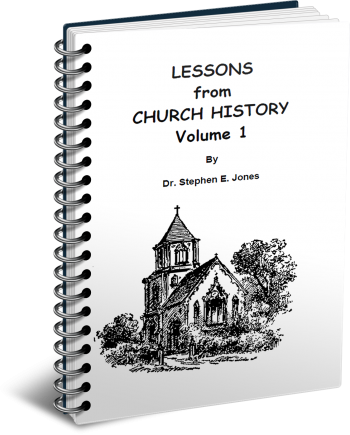Latest Posts
View the latest posts in an easy-to-read list format, with filtering options.

Volume 1. This gives a short history of the Church from the apostles to the Roman War, including Luke’s account of Paul’s journeys in the book of Acts. It includes Paul’s fourth missionary journey to Spain and Britain.
Category - History and Prophecy

Paul arrived in Rome early in the year 61 A.D. He remained there two years (Acts 28:30) before appearing before Nero in 63.
Nero's early years are called his “Golden Years,” because he was a relatively good ruler. But absolute power corrupted his morals. At first these things were done more secretly, and finally openly. He had married Octavia quite early, but he soon proved to be bisexual. Suetonius tells us:
“Besides abusing freeborn boys and seducing married women, he debauched the vestal virgin Rubria. The freedwoman Acte he all but made his lawful wife, after bribing some ex-consuls to perjure themselves by swearing that she was of royal birth. He castrated the boy Sporus and actually tried to make a woman of him; and he married him with all the usual ceremonies, including a dowry and a bridal veil, took him to his home attended by a great throng, and treated him as his wife.” (Nero, XXVIII)
Suetonius says also that he did the same with another man named
“Doryphorus, for he was even married to this man in the same way that he himself had married Sporus.” (Nero, XXIX)
Nero also erected a colossal statue of himself 120 feet high in a palace called “The Golden House.” This statue was likely Paul’s prophetic model for the “man of sin” in 2 Thess. 2:4.
The book of Acts ends with Paul in Rome, telling us only that he remained there under house arrest for a period of two years. This was a tumultuous two year period. Paul's fellow philosopher, Seneca, helped him the first year but lost influence in 62 before Paul's day in court.
To give you a little background about Seneca, in 41 A.D. the Emperor Claudius had banished Seneca to Corsica at the request of his first wife, Messalina, but was recalled in 49 at the request of Claudius’ second wife, Agrippina—who was Nero's mother. She hired Seneca as Nero’s tutor. After Nero became emperor, Seneca lost influence as the emperor became morally corrupted. The foreclosure on Seneca’s usurious loan to King Prasutagus in Britain was also the occasion of the disastrous Boadicean War, and this too affected his approval rating negatively.
Finally, Seneca was accused by Nero of embezzlement, forcing his retirement in 62. Ultimately, he was accused of involvement in the Pisonian conspiracy and forced to commit suicide in 65.
Burrus, the Prefect of the Guard, was Nero’s other advisor who had had a good influence upon him—until 62 A.D. when Nero murdered him by sending him poison in the guise of throat medicine.
The book of Acts says nothing of Paul’s execution, though Luke certainly would have recorded this, if that had been Paul's fate at that time. We can only conclude from Acts that Paul left Rome after being there two years. But here is where Luke's account ends, or seems to end, until we look at the Sonnini Manuscript, which has a 29th chapter to the book. This 29th chapter of Acts is reproduced in full in Appendix 1.
Acts 29 tells us that Paul preached the Word in Spain, where “great multitudes believed and were converted” (29:6). There were, of course, many Hebrew people in Spain, and it was therefore called the Iberian Peninsula. Iberia is from the name Heber, from which is derived the name “Hebrew.” Thus, when Paul arrived there, he found many ex-Israelites of the dispersion to whom the Gospel was welcome.
From there Paul sailed to Britain, landing in Raphinus (29:7), which was the Roman name for the town of Sandwich in Kent. Verse 8 says,
“Now when it was voiced abroad that the Apostle had landed on their coast, great multitudes of the inhabitants met him, and they treated Paul courteously and he entered in at the east gate of their city and lodged in the house of an Hebrew and one of his own nation.”
The wording indicates that Paul was a guest of a more recent Christian migrant from Judea to Britain, and that the people in general had heard of Paul's conversion either from him or from Joseph of Arimathea or another of the apostles who had visited there previously. Verse 13 says,
“And it came to pass that certain of the Druids came unto Paul privately, and showed by their rites and ceremonies they were descended from the Jews [Judahites] which escaped from bondage in the land of Egypt, and the Apostle believed these things, and he gave them the kiss of peace.”
Paul then remained three months (29:14) before sailing to Atium in Gaul (now France), where he preached in the Roman garrisons. From there it is said that he went to Helvetia (now Switzerland) “and came to Mount Pontius Pilate, where he who condemned the Lord Jesus dashed himself down headlong, and so miserably perished” (vs. 18).
Pilate’s suicide was apparently well known to Eusebius, the 4th century Church historian, for he tells us in Eccl. History, II, vii,
“Pilate himself, the governor of our Saviour's day, was involved in such calamities that he was forced to become his own executioner and to punish himself with his own hand.”
An earlier writer, Tertullian (Defense, 21) says that “he was in his heart a Christian,” if not at the time of the crucifixion, then certainly shortly afterward before he was exiled to Gaul in 38 A.D. Certainly, his wife, Portia, was a believer, as she is favorably mentioned in Matt. 27:19.
It is interesting that Paul is said to have received a revelation about Pilate when viewing the place of his suicide. Acts 29:22 says,
“And a voice came out of heaven saying, Even Pilate hath escaped the wrath to come, for he washed his hands before the multitude at the blood-shedding of the Lord Jesus.”
From there Paul went to Illyricum, where Paul had already preached the Gospel (Rom. 15:19). This province was on the eastern side of the Adriatic Sea, across from Italy, where Albania is now located. Paul intended to go through Macedonia into Asia, presumably to revisit the churches where he had ministered in earlier years. It had been about five years since he had visited them, for he had been under arrest for four of those years.
After this, we find Paul and Peter being executed under Nero some time between 64 and 67 A.D. Since Nero committed suicide on June 9, 68 A.D., it could not have been later than then. Yet we do know that he began to persecute Christians after blaming them for the great fire that destroyed most of Rome in July of 64 A.D. Suetonius wrote:
“Punishment was inflicted on the Christians, a class of men given to a new and mischievous superstition.” [Nero, XVI]
Suetonius himself puts the blame on Nero, saying,
“For under cover of displeasure at the ugliness of the old buildings and the narrow, crooked streets, he set fire to the city so openly that several ex-consuls did venture to lay hands on his chamberlains although they caught them on their estates with tow and firebrands, while some granaries near the Golden House, whose room he particularly desired, were demolished by engines of war and then set on fire, because their walls were of stone. For six days and seven nights destruction raged, while the people were driven for shelter to monuments and tombs. . . . Viewing the conflagration from the tower of Maecenas, and exulting, as he [Nero] said, ‘with the beauty of the flames,’ he sang the whole time the Sack of Ilium in his regular stage costume.” [Nero, XXXVIII]
This is how the saying came about that is used even today, “fiddling while Rome burns.” In reality, it appears that Nero sang an opera, rather than playing the fiddle, while Rome burned.
Later, Suetonius tells us that before setting the city on fire, he contemplated “letting the wild beasts loose, that it might be harder for the people to protect themselves. But he was deterred from these designs.”
After the fire, Rome, which had protected Christians from the Jews, now became their persecutors. Since Paul is said to have preached in Britain only three months before returning via Gaul and Switzerland, it seems most likely that he returned to Greece by 64 A.D. He also intended to visit the churches in Asia one final time before his arrest and martyrdom. This must have taken at least a year. He was probably executed, then, no earlier than 65, probably in 67.
However, he had one final work to complete after his arrest in Rome but before he was martyred. It was the work of collaborating with Peter and John to canonize the writings of the apostles as Scripture that would come to be known as the New Testament.